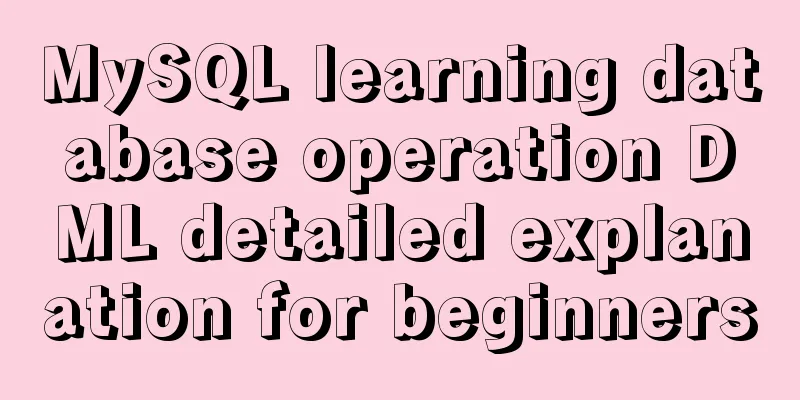MySQL learning database operation DML detailed explanation for beginners

1. Insert statement1.1 Insert a row There are two types: Note: If there is no parenthesis after the table name, all columns will be added by default. 2. In set form
1.2 Insert multiple rows
Note that multi-row insertion and join query statements are not supported here, and the primary key cannot be empty or repeated. 1.3 Insert query statement
Note that the query statement is run first and then the query result set is inserted into the table, but it must correspond to the column after the table name. The primary key cannot be repeated and cannot be empty, otherwise the insertion will fail. 2. Modify the statement2.1 Modify single table records
2.2 Modify multi-table records1. Use sql92 syntax
2. Use sql99 syntax
3. Delete statement3.1 Method 1: Use delete to delete1. Single table deletion
Will delete all the corresponding data in a whole row 2. Multiple table deletion
This is sql99 syntax, and sql92 syntax is also supported. The table after delete is the table whose contents are to be deleted. 3.2 Method 2: Delete using truncate
Directly delete the data of the entire table 3.3 The difference between using truncate and delete 1. delete can add where conditions but truncat cannot The above is the detailed content of MySQL learning: a detailed explanation of database operation DML for beginners. For more information about MySQL database operation DML, please pay attention to other related articles on 123WORDPRESS.COM! You may also be interested in:
|
<<: html opens a new window with a hyperlink and can control window properties
>>: Discussion on the Issues of Image Button Submission and Form Repeated Submission
Recommend
Use Javascript to implement the function of sending SMS verification code interval
In many apps and websites, when we log in or regi...
Detailed explanation of AWS free server application and network proxy setup tutorial
Table of contents Precautions Necessary condition...
Detailed explanation of the execution differences between count(1), count(*) and count(column name)
Implementation effect: 1. count(1) and count(*) W...
Example of how to check the capacity of MySQL database table
This article introduces the command statements fo...
Two ways to manually implement MySQL dual-machine hot standby on Alibaba Cloud Server
1. Concept 1. The difference between hot backup a...
MySQL time difference functions (TIMESTAMPDIFF, DATEDIFF), date conversion calculation functions (date_add, day, date_format, str_to_date)
1. Time difference functions (TIMESTAMPDIFF, DATE...
How to install Docker CE on Ubuntu 18.04 (Community Edition)
Uninstall old versions If you have installed an o...
How to transfer files between Docker container and local machine
To transfer files between the host and the contai...
MySQL trigger syntax and application examples
This article uses examples to illustrate the synt...
Detailed explanation of how CocosCreator system events are generated and triggered
Table of contents environment summary Module Func...
MYSQL A question about using character functions to filter data
Problem description: structure: test has two fiel...
Cross-host communication between docker containers-overlay-based implementation method
Overlay network analysis Built-in cross-host netw...
An article teaches you how to implement VUE multiple DIVs and button binding enter events
There is currently a requirement that an operatio...
Docker deploys mysql to achieve remote connection sample code
1.docker search mysql查看mysql版本 2. docker pull mys...
Docker Swarm from deployment to basic operations
About Docker Swarm Docker Swarm consists of two p...









